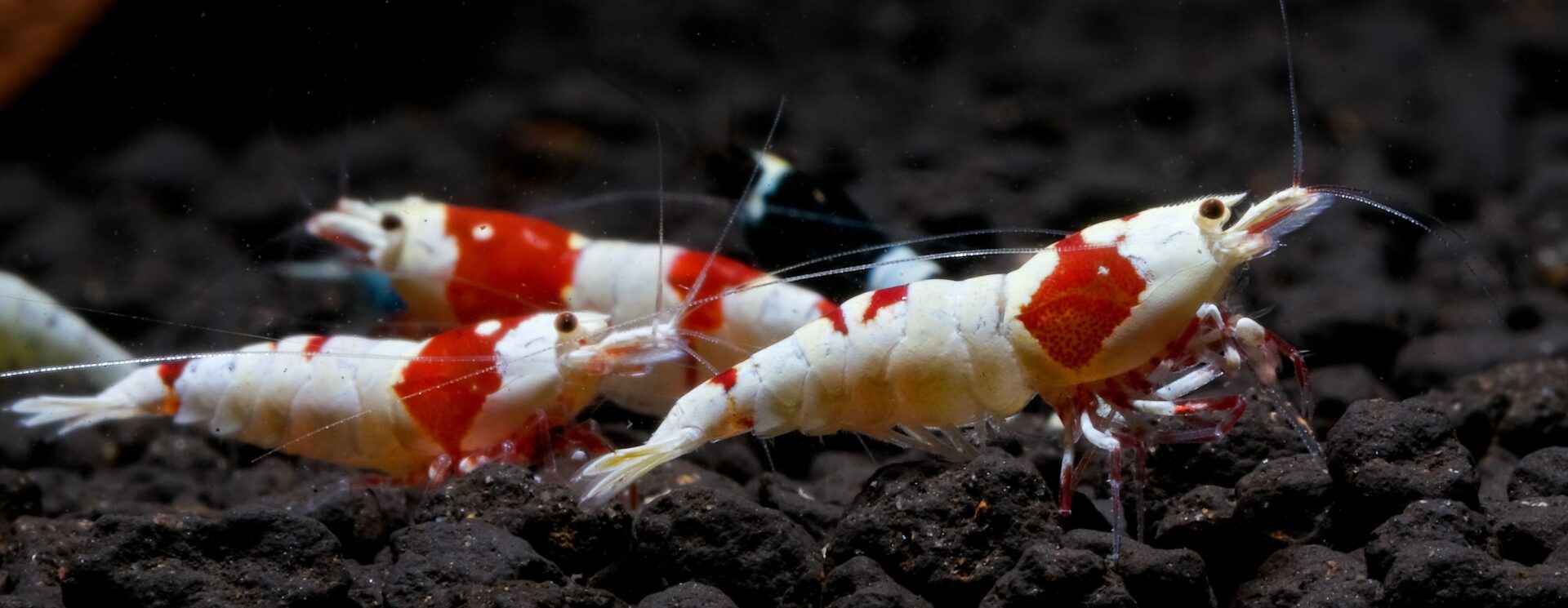Crystal Red Shrimp (Caridina cf. logemanni) and Crystal Black Shrimp are varieties of dwarf shrimp native to Taiwan that have become hugely popular in the aquarium hobby. Their key appeal is their stunning coloration – a mix of vibrant red and crisp white sections in CRS, and solid black and white patterns in CBS. This color variation between individual shrimp allows hobbyists to selectively breed towards higher aesthetic grades over generations. Despite their small size around 1 inch, these peaceful shrimp can be the vibrant centerpiece of a home aquarium with the right water conditions.
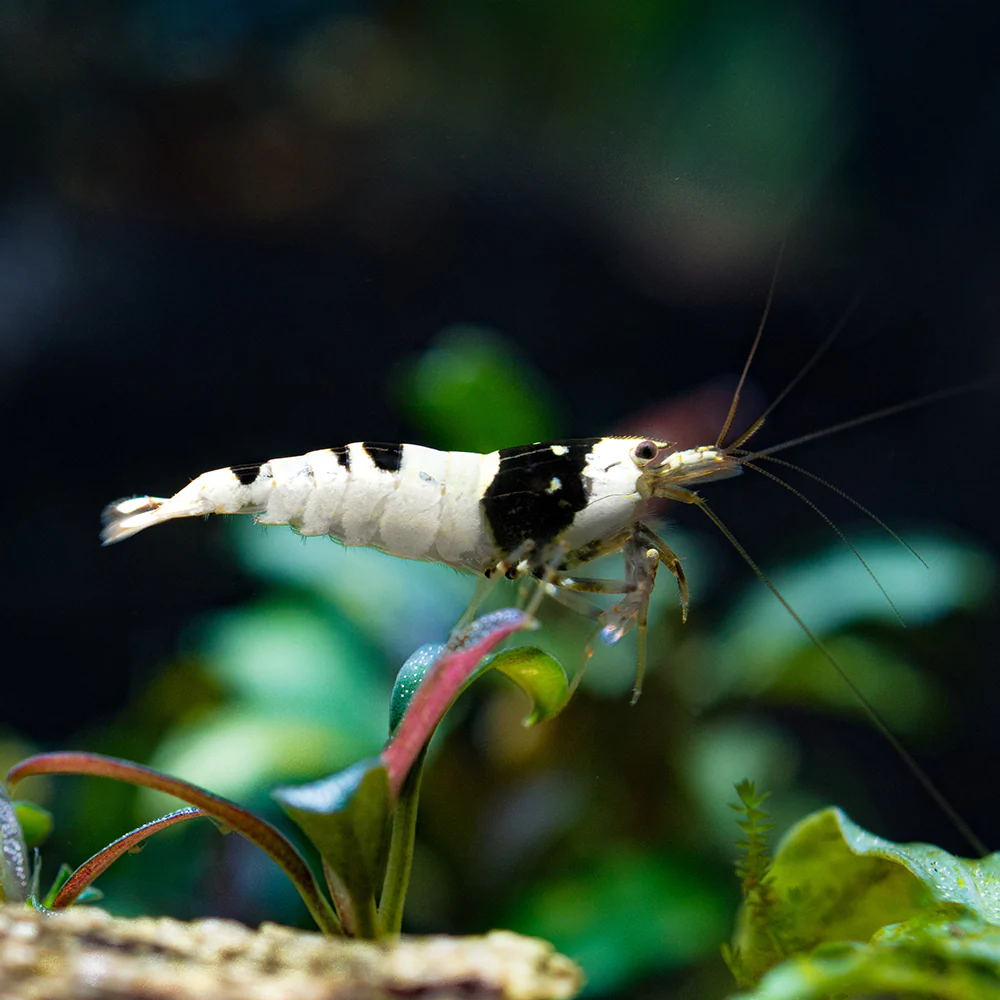
Importance of grading systems in the hobby
As the popularity of keeping and breeding high-quality CRS and CBS has grown, standardized grading systems have become essential tools in the hobby. Grading allows for consistent evaluation and categorization of the shrimp’s aesthetic qualities like color intensity, pattern, and white coverage. This provides a shared reference for quality that facilitates buying, selling, trading, and discussing shrimp specimens. Breeders rely on grading to set Goals for selectively improving traits towards higher levels over successive generations. The different grades also help determine rarity and market value, with premium prices paid for the most vivid and distinctly patterned shrimp.
Grading Systems
German K0-14 Scale
The German K0-14 scale, developed by the Logemann brothers, is one of the most widely used for grading the quality and aesthetics of Crystal Red and Black Shrimp. It assigns numerical grades from K0 (lowest) to K14 (highest) based primarily on the ratio and distribution of white opaque coloration on the shrimp’s body.
Grading Criteria
K0: Shrimp exhibits very little to no white coloration.
K2: Faint white markings but overall body is predominantly red/black.
K4: Approximately 50% white and 50% red/black coverage.
K6: White is the primary color with distinct opaque coverage.
K8: Very intense, evenly opaque white covers most of the body. Some vivid red/black remains.
K10: Punchy solid white dominates with only minor red/black spots/trim left.
K12: Solid white dominates with even less transparency than K10 grade. Clean colors. Solid leg coloration.
K14: Considered an ideal specimen with seamless solid white to the naked eye, no transparency whatsoever. Vivid and distinct red/black patterns. 100% colored legs.
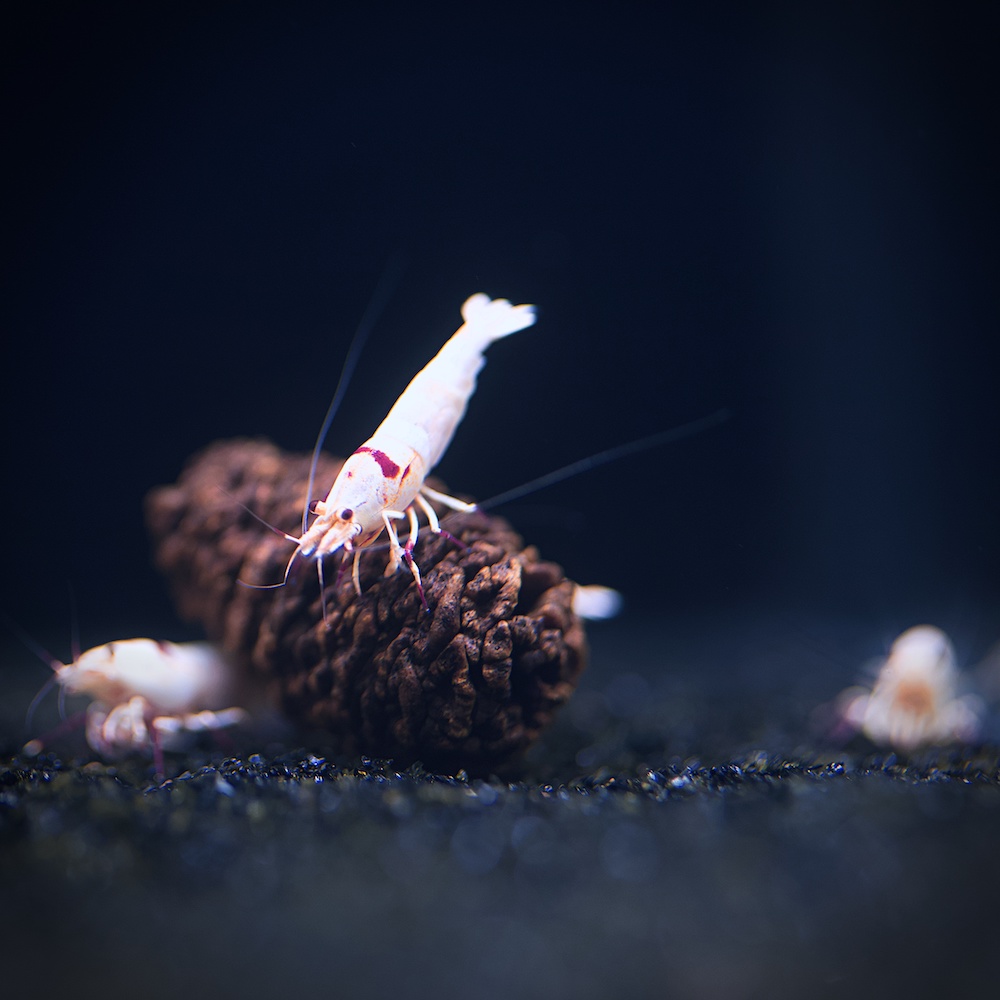
International C-SSS+ System
The international C-SSS+ system uses letter grades to evaluate shrimp quality focusing on the intensity and coverage of white versus red/black coloration.
Grading Criteria
C: Shrimp has mostly solid red/black body with minimal white. Colors appear washed out.
B: Faint white stripes but red/black is still dominant. Lacks color vibrancy.
A: Even amounts of white and red/black. White has decent opacity, red/black appears blotchy.
S: White is the primary color. Red/black areas are solid/intense. Some patchiness between colors.
SS: Very intense, evenly spread opaque white. Solid vivid red/black remains on segments. Non-transparent leg coloration.
SS+: Solid white dominates with even less transparency than SS grade. Clean colors. Solid leg coloration.
SSS: Virtually no transparent spots on the shell – shrimp is an opaque pure white with minimal red/black patterns. Leg coloration is equally as clean and thick.
SSS+: Considered an ideal specimen with seamless solid white to the naked eye, no transparency whatsoever. Vivid and distinct red/black patterns. 100% colored legs.
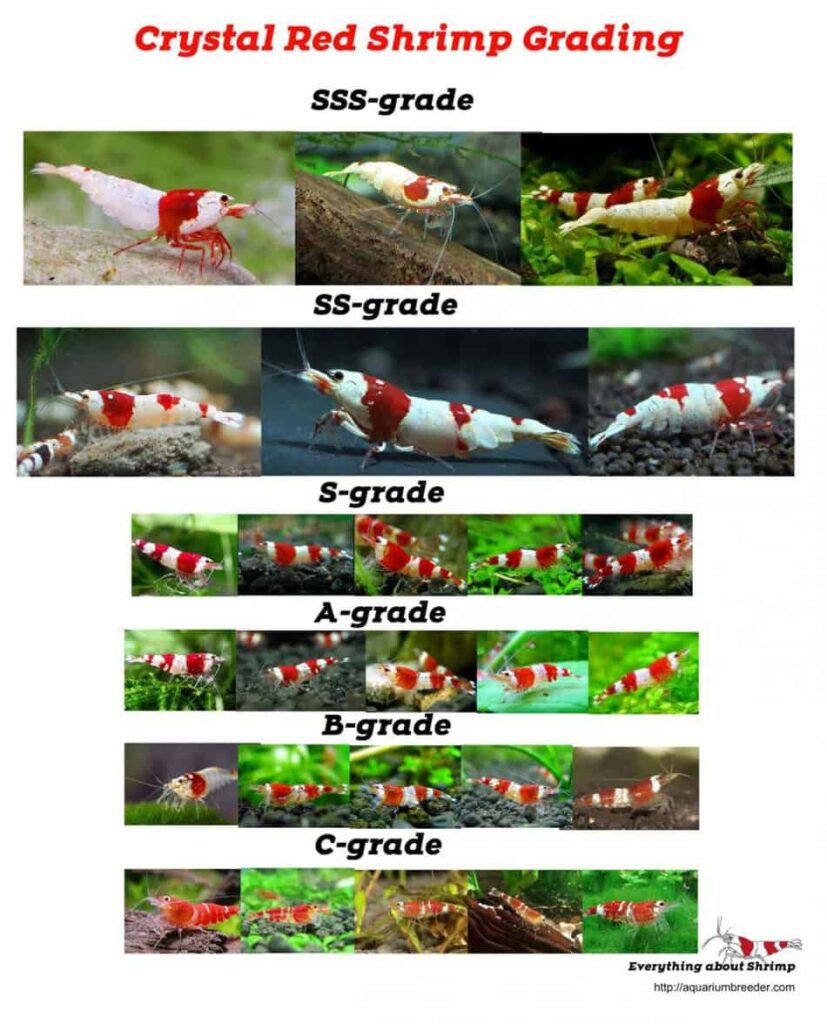
Color Grading
In grading crystal shrimp, the intensity, opacity, and solidity of the red/black and white coloration are critical factor. Vibrant, deep colors indicate healthier shrimp and superior genetics.
Ideal red/black color characteristics
For the red/black portions, breeders look for an intense, solid, even red/black hue across the full segment without any paling or transparency. Colors that appear washed out, blotchy, or where you can see the internal organs reduce the grade.
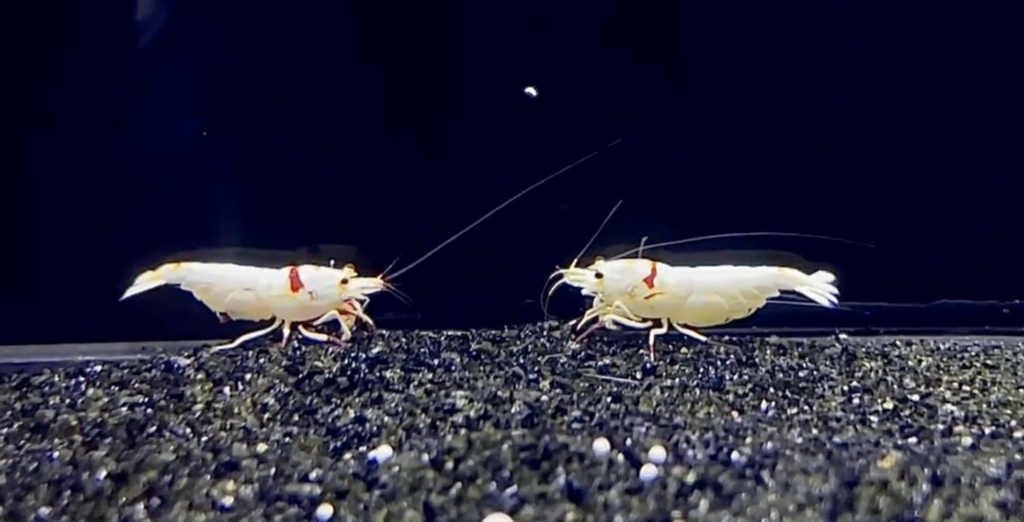
Ideal white color characteristics
The goal for the white sections is an opaque, solid, bright white coloration throughout the entire area with no transparent “windows” or streaks. The whiter and more evenly colored, the higher the grade.
Attaining the higher SSS color grades requires exceptional opacity, brightness and distinct separation of the red and white colors across the entire body.
Pattern Grading
While color intensity is often the highest priority in grading crystal shrimp, the patterns and markings are also an important aesthetic factor, especially at the higher SSS grade levels.
Key patterns in SSS-grade
These are some of the most prized and distinctive patterns exhibited by top SSS grade shrimp:
- Smiley Faces: Solid white with a red/black marking on the head and a dash behind it, creating a smiley face from above.
- Mosura Crown: A semicircular crown-like red/black marking on the top/side of the head with connected rhombuses.
- Mosura Flower: White spots on the red/black sides of the carapace, resembling flowers when viewed from the side.
- Mosura Heart: A heart-shaped red/black dash on top of the carapace, visible from the side.
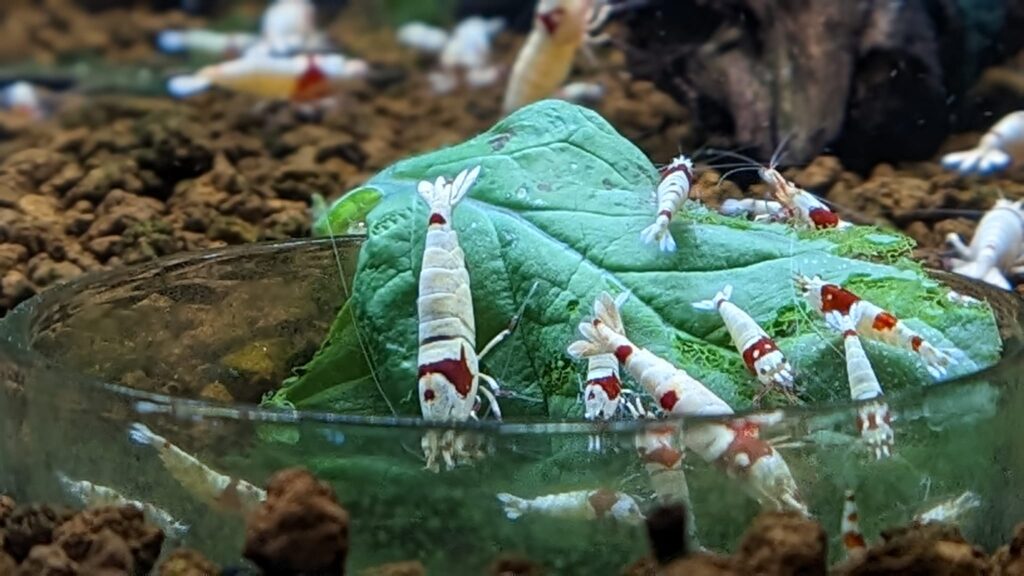
Key patterns in SS-grade
- Hinomaru (Rising Sun): Red/black carapace with white horizontal bands and reduced red/black band on abdomen forming a spot/circle.
- Double Hinomaru: Similar to Hinomaru but with an additional small red/black dot on the tail segment.
- Stop or No Entry Sign: Red/black carapace with white bands and a red/black spot with white line on abdomen, like a no entry sign.
- Half Moon: Red/black carapace with white bands and a semi-circle red/black spot on abdomen.
- Little Lips: Red/black carapace with white bands and a red/black spot divided by white line, resembling lips.
- Japanese Flag: Red/black spot in a round shape on white abdomen, resembling Japanese flag.
- Large Maro: Two white dots on red/black carapace behind head, sometimes called “Godzilla eyes.”
Key Patterns in S-grade
- Tiger-Toothed: Red/black carapace, white bands, red/black band on abdomen with two downward points.
- V-Banded: Red/black carapace, white bands, V-shaped red/black band on abdomen.
- Small Maro: Two small white dots on red/black carapace behind head.
- Four White Bands: Body has four white bands and three red/black bands.
- Three White Bands: Body has three white bands, two red bands, red/semi-red tail.
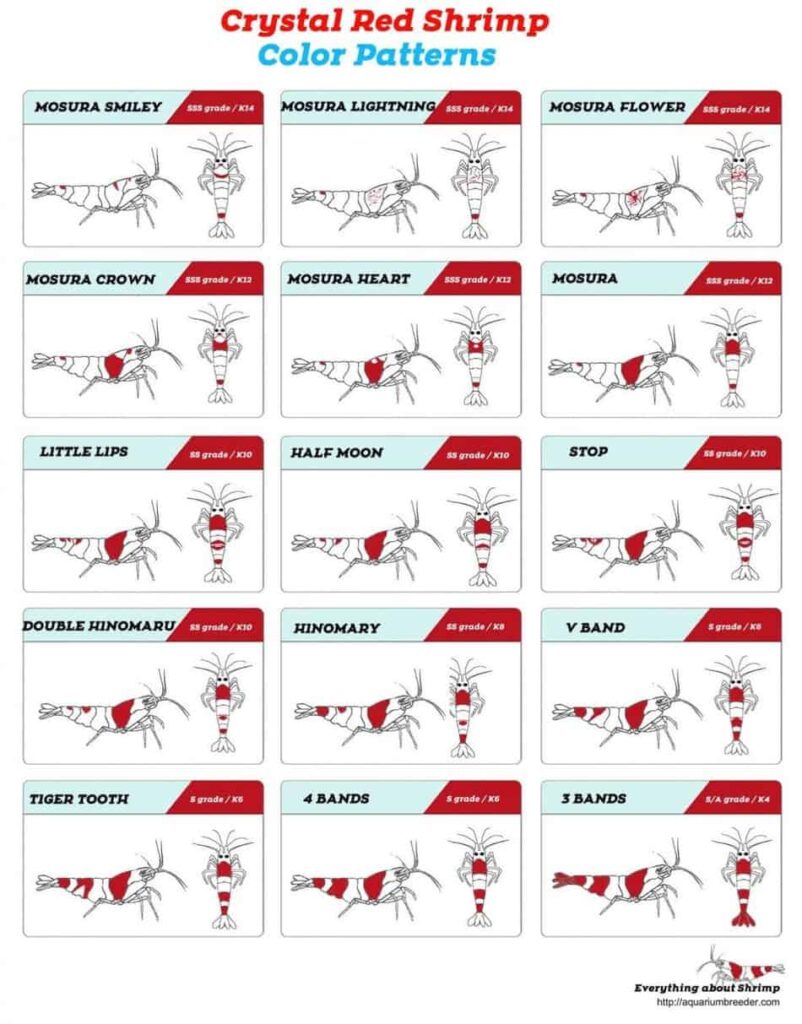 Factors Affecting Grading
Factors Affecting Grading
Importance of white coverage and intensity
The extent and intensity of the white coloration are crucial factors in determining a crystal shrimp’s overall grade. Higher grades feature extensive, solid white patches, especially on the carapace and abdomen. This vibrant, opaque white indicates superior health and genetics.
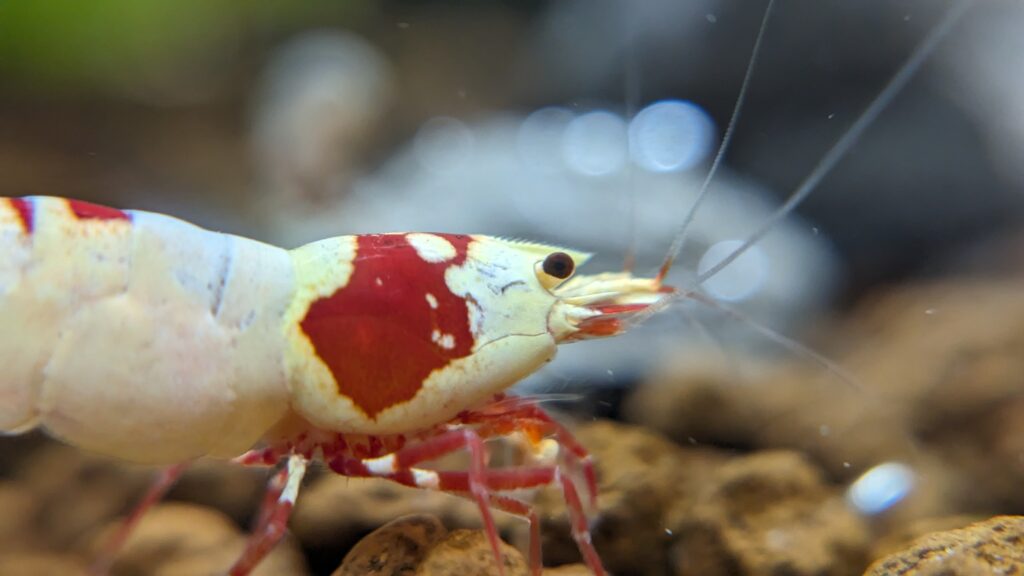
Effect of transparent areas
Transparent areas or “windows” in the shrimp’s white coloration can significantly lower its grade. These clear spots or bands break up the continuity of the patterns, diminishing the visual appeal. Transparency often signals suboptimal health or genetics.
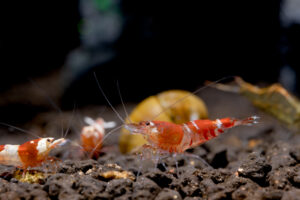
Impact of stress and age on white coloration
Environmental stressors like poor water quality or nutrition can cause the white areas to fade, become patchy or take on a yellowish tinge in crystal shrimp. This “whiting out” reduces the shrimp’s grade. Additionally, older shrimp naturally exhibit less intense, more opaque white patches as they age, which can impact their grading potential compared to younger, more vivid shrimp. Maintaining stable water conditions and proper care is essential for crystal shrimp to display their full vibrant white coloration for high grading.
Color vs. Pattern: Which is More Important?
Prioritizing color over pattern In the world of crystal shrimp breeding, vibrant and solid coloration often takes precedence over intricate patterns when evaluating quality. While both aspects contribute to a shrimp’s overall appeal, superior color is generally the higher priority.
Reasons for color precedence
Indicators of health and genetics
Intense, opaque colors signal strong genetics and overall vitality in the shrimp. Shrimp with washed-out or blotchy colors may have underlying health or genetic issues.
Stability and visual appeal
Solid, evenly-colored red/black and white sections are more visually striking and stable traits than intricate patterns, which can be less consistent.
Market value
At auctions and sales, shrimp with superior color quality and higher grades tend to attract higher prices from buyers. Even if a shrimp has an exceptional pattern, dull or translucent colors decrease its overall value in the market.
While having a well-defined, distinct pattern is still desirable for high-end shrimp, vibrant and consistent coloration across the entire body is considered the most important factor in grading and breeding quality crystal red and black shrimp.
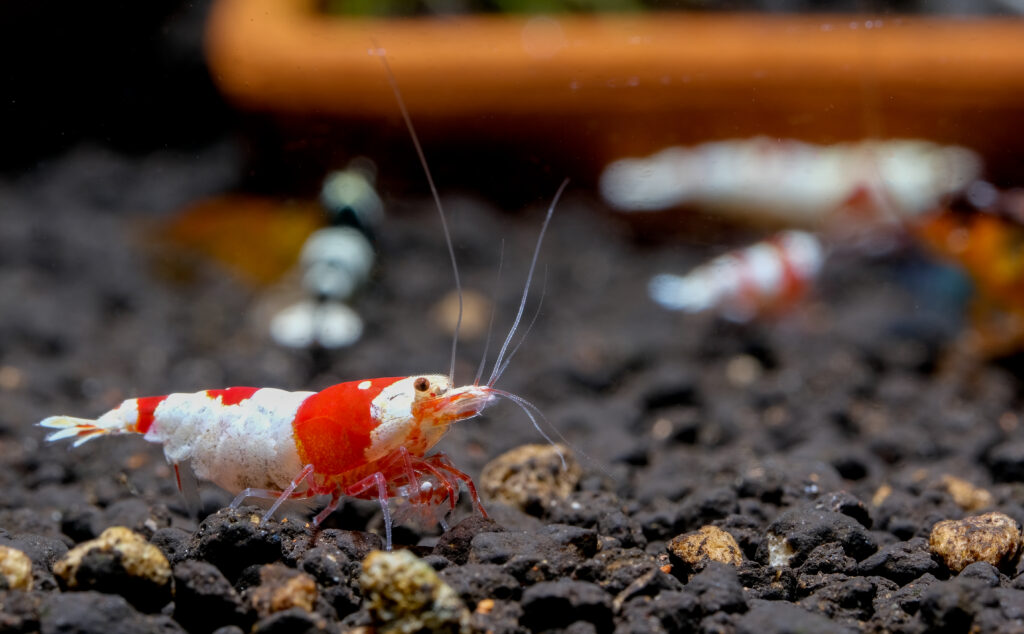
How to Inspect and Grade CRS/CBS
Grading crystal red and black shrimp requires careful inspection and a keen eye for detail. Follow these tips to ensure accurate evaluation:
Proper lighting
Use adequate lighting like natural daylight or high-quality aquarium lights to clearly see the true colors and patterns. Improper lighting can wash out colors.
Examining from multiple angles
View the shrimp from the top, side, and bottom to assess full-color coverage and pattern consistency from all angles.
Assessing color intensity and coverage
Pay close attention to the brightness, opacity, and extent of the red and white patches over the body sections.
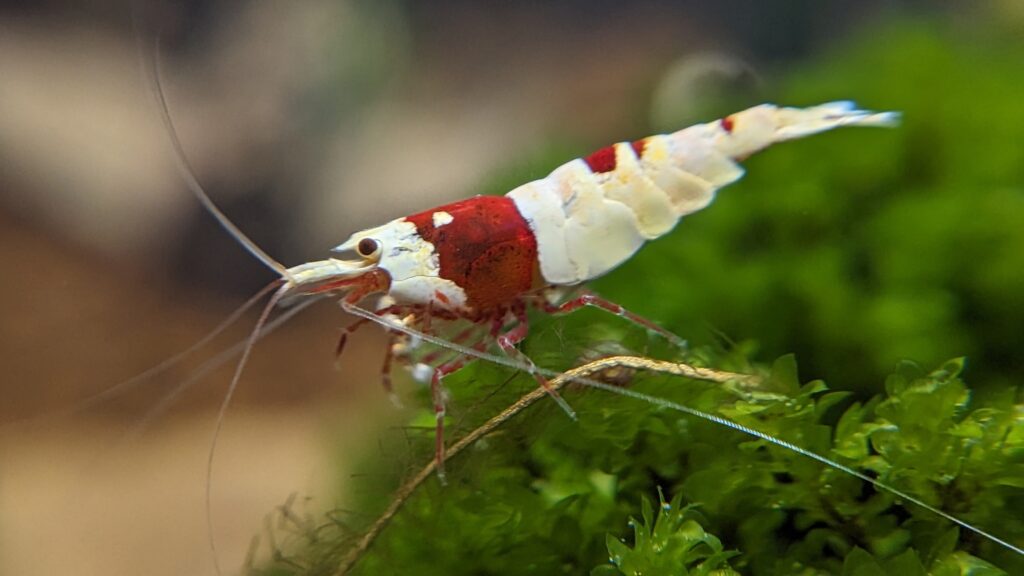
Checking for transparency
Inspect for any transparent “window” areas that can lower the grade.
Identifying patterns
Categorize the shrimp’s pattern according to established SS, and S grade examples.
Considering health and behavior
Active, healthy shrimp with solid colors and patterns are more likely to be higher-quality specimens.
Importance of a trained eye
Accurately grading the subtle differences in color intensity, pattern definition and transparency takes practice. Experienced breeders develop an expert eye for discerning top-tier shrimp.
Spend time observing and comparing many shrimp to hone your grading skills over time. A trained eye is crucial for consistently evaluating crystal shrimp quality.

